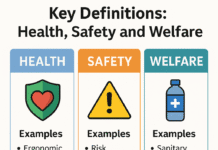
Safety Committee Meetings: Safeguarding the Workplace
In any organization, ensuring a safe working environment is paramount. One of the key tools in achieving this is the safety committee meeting. This article will delve into the intricacies of safety committee meetings, exploring their purpose, planning, execution, and the various challenges they address.
Introduction
Definition of a Safety Committee Meeting
Safety committee meetings are organized gatherings where representatives from different departments come together to discuss and address workplace safety concerns. These meetings serve as a forum for identifying, evaluating, and mitigating potential hazards, promoting a culture of safety within the organization.
Importance of Safety Committee Meetings
Safety committee meetings play a crucial role in fostering a safe and healthy work environment. By bringing together diverse perspectives and expertise, these meetings contribute to the development and implementation of effective safety measures.
Purpose of Safety Committee Meetings
Identifying Workplace Hazards
One primary purpose of safety committee meetings is to identify and assess workplace hazards. Committee members collaborate to analyze incident reports, inspect work areas, and proactively address potential dangers.
Implementing Safety Policies
Safety committee meetings serve as a platform for developing and implementing safety policies. By establishing clear guidelines and protocols, organizations can ensure that employees adhere to safety standards.
Promoting Employee Involvement
Involving employees in safety discussions fosters a sense of ownership and responsibility. Safety committee meetings provide an avenue for employees to voice concerns, share insights, and actively participate in creating a safer workplace.
Planning and Organizing a Safety Committee Meeting
Setting Agendas and Goals
Effective safety committee meetings begin with well-defined agendas and goals. Establishing priorities ensures that discussions remain focused on addressing critical safety issues.
Selecting Meeting Frequency
Determining the frequency of safety committee meetings depends on the nature of the workplace and associated risks. Regular meetings help maintain a proactive approach to safety.
Ensuring Attendance and Participation
Attendance and active participation are essential for the success of safety committee meetings. Encouraging commitment from all members ensures diverse perspectives are considered in decision-making.
Conducting Safety Inspections
Reviewing Incident Reports
Committee members review incident reports to understand past issues and identify recurring patterns. This retrospective analysis guides discussions on preventive measures.
Inspecting Work Areas
Physical inspections of work areas are vital components of safety committee meetings. Identifying potential hazards on-site allows for targeted interventions and improvements.
Collaborating with Experts
Incorporating external experts, such as safety professionals or industrial hygienists, enhances the committee’s ability to identify and address complex safety challenges.
Communication in Safety Committee Meetings
Importance of Open Communication
Open communication is the foundation of effective safety committee meetings. Creating an environment where members feel comfortable expressing concerns fosters collaboration and problem-solving.
Encouraging Employee Feedback
Actively seeking and valuing employee feedback empowers the workforce. Safety committee meetings should provide a platform for employees to share observations and suggestions.
Effective Communication Strategies
Utilizing clear and concise communication strategies ensures that safety messages are understood by all members. Avoiding jargon and technical language promotes inclusivity.
Implementing Safety Training Programs
Identifying Training Needs
Safety committee meetings assess training needs by analyzing incident trends and emerging risks. Identifying gaps allows for targeted training programs.
Collaborating with Training Professionals
Engaging with training professionals ensures that safety programs are well-designed and effectively delivered. Expertise in adult learning principles enhances the impact of training sessions.
Ensuring Ongoing Education
Safety is a dynamic field, and continuous education is crucial. Safety committee meetings should allocate time for ongoing training to keep members informed about the latest safety practices.
Monitoring and Evaluating Safety Programs
Establishing Key Performance Indicators
Measuring the effectiveness of safety programs requires establishing key performance indicators (KPIs). Regularly assessing these KPIs provides insights into program success and areas for improvement.
Regular Audits and Assessments
Periodic audits and assessments are integral to maintaining a proactive safety stance. Regular evaluations ensure that safety protocols are being followed and identify areas needing enhancement.
Continuous Improvement Strategies
Safety committee meetings should include discussions on continuous improvement strategies. Analyzing past performance and seeking innovative solutions contribute to the evolution of safety programs.
Handling Emergency Preparedness
Developing Emergency Response Plans
Safety committee meetings play a vital role in developing and refining emergency response plans. Preparedness discussions ensure that organizations can effectively respond to unexpected events.
Conducting Drills and Exercises
Practical drills and exercises enhance the effectiveness of emergency response plans. Safety committee meetings should allocate time for reviewing and updating these plans based on drill outcomes.
Evaluating and Adjusting Plans
Regular evaluations of emergency response plans are crucial. Safety committee meetings provide a platform to discuss lessons learned from real incidents and adjust plans accordingly.
Legal Compliance in Safety Committee Meetings
Understanding OSHA Regulations
Safety committee meetings should prioritize understanding and adhering to Occupational Safety and Health Administration (OSHA) regulations. Compliance ensures legal protection and a commitment to employee well-being.
Regular Updates on Compliance
Keeping abreast of updates to safety regulations is essential. Safety committee meetings should include discussions on recent changes in laws and regulations affecting workplace safety.
Implications of Non-Compliance
Understanding the implications of non-compliance emphasizes the importance of safety committee meetings. Legal consequences and potential harm to employees underscore the need for rigorous safety measures.
Reporting and Documenting Safety Committee Activities
Keeping Detailed Records
Thorough documentation of safety committee activities is critical. Detailed records provide a historical perspective and serve as a reference for future safety initiatives.
Transparency and Accountability
Transparency in reporting ensures that all stakeholders, including employees, are aware of safety initiatives and outcomes. Accountability reinforces the commitment to a safe workplace.
Reporting to Stakeholders
Safety committee meetings should include discussions on reporting safety activities to stakeholders. Transparency builds trust, and stakeholders appreciate organizations that prioritize safety.
Challenges and Solutions in Safety Committee Meetings
Addressing Resistance to Safety Measures
Resistance to safety measures can be a challenge. Safety committee meetings should address concerns, provide education, and foster a culture where safety is seen as everyone’s responsibility.
Overcoming Communication Barriers
Effective communication can be impeded by various factors. Safety committee meetings should explore solutions to communication barriers, ensuring that all members feel heard and understood.
Continuous Improvement Strategies
Continuous improvement should be an ongoing theme in safety committee meetings. Proactively seeking ways to enhance safety protocols and processes keeps the organization ahead of potential risks.
Conclusion
In conclusion, safety committee meetings are indispensable for maintaining a secure work environment. By actively engaging in hazard identification, communication, training, and continuous improvement, organizations can create a culture where safety is prioritized by all.
Occupational Health and Safety Management Systems
Oil and Gas Industry Safety 2024
FAQs
How often should safety committee meetings be conducted?
Safety committee meetings should be conducted regularly, with the frequency determined by the nature of the workplace and associated risks. Monthly or quarterly meetings are common, but the key is to maintain a proactive approach to safety.
What are the legal implications of not having a safety committee?
Not having a safety committee can result in legal consequences, especially if an organization is subject to OSHA regulations. Lack of safety measures may lead to fines, lawsuits, and potential harm to employees.
How can employees actively contribute to safety discussions?
Employees can actively contribute by participating in safety committee meetings, providing feedback, reporting hazards, and actively engaging in safety training programs. Their involvement is crucial for creating a safer workplace.
Are safety committee meetings mandatory for all businesses?
The requirement for safety committee meetings varies by jurisdiction and industry. In some regions, certain businesses are mandated to have safety committees, while others may not have a legal obligation but are encouraged to establish them for employee well-being.






















Good elaboration. Thank you.